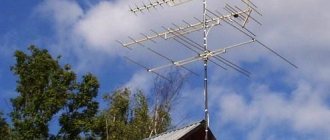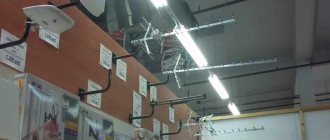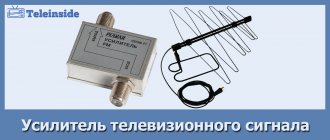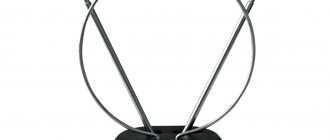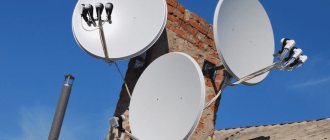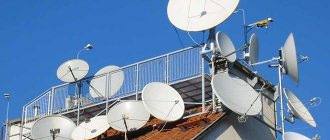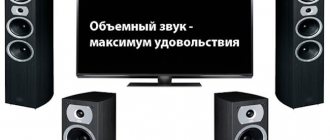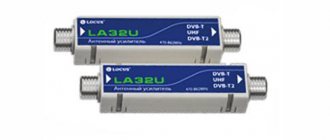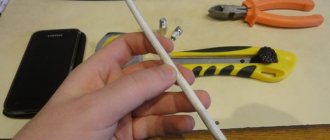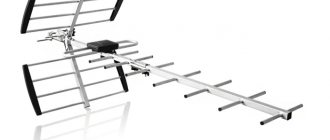| Place | Name | Characteristics in the rating |
| The best over-the-air antennas for a summer residence |
| 1 | Hyundai H-TAE220 | The best ratio of price and quality |
| 2 | "Meridian" 07AF Turbo | The most reliable model |
| 3 | Selenga 131F | Foldable design |
| 4 | Locus Zenit-20-AF | Best price |
| 5 | LUMAX DA2501A | Effective signal reception at a great distance from the tower |
| The best satellite dishes for a summer residence |
| 1 | "Supral" (90 cm) | Better signal quality |
| 2 | LANS-97 (MS 9707 GS/AS) | The most practical offset antenna model |
| 3 | TbTec (100 cm) | Optimal reliability indicators |
| 4 | GIBERTINI PL-85A | The most durable |
| 5 | Universal (90 cm) | High quality digital signal support. Possibility of uninterrupted operation on the Internet |
| The best indoor antennas for a summer residence |
| 1 | Delta K131A.03 | Buyer's Best Choice |
| 2 | Thomson ANT1487 | The most powerful amplifier |
| 3 | REMO BAS-5121-DX FOBOS 2.1 | Affordable price |
| 4 | FIRST AUSTRIA FA 3100 | Optimal reception characteristics |
| 5 | Vector AR-032 | Built-in clock. Excellent signal enhancement |
The best satellite dishes for a summer residence
Structurally, these antennas are large parabolic housings with a feeder (in common parlance - a “gun”), operating on the principle of focusing waves of a certain frequency range. Such models are capable of receiving signals from satellites, which eliminates the occurrence of “natural” interference in the form of forests, high-rise buildings, mountains, etc. This feature of antennas is ideally suited for buildings remote from large urban centers, including summer cottages. Satellite receivers are somewhat more expensive than terrestrial models, but in the vast majority of cases they are much more stable.
Is the amplifier that important?
It is designed to reduce signal loss on the cable. The microcircuit does not act as a panacea that can change the situation if the antenna itself does not catch the signal, or the picture quality needs to be significantly improved. It is only necessary if the receiver is located at a remote distance from the TV. The amplifier truly reveals itself when the antenna is distant from the TV, from 30 m and above. In such cases, when the signal “reaches” the cable, its power will weaken. You should also consider purchasing this device if the signal received from the repeater is weak. And the already amplified signal is sent through the cable to the tuner.
In what case can you do without it:
- the signal power is several times stronger than necessary;
- in addition to television channels, the receiver picks up extraneous noise;
- The reception level is at a critical level.
Things to consider during installation:
- Requires power supply. For its installation, a power supply is included with the product. Exceptions are possible only if the part requires 5 V to operate. In this case, electricity can be supplied from the tuner itself. In this case, the current will be of high quality without ripple. Unfortunately, the vast majority require 12V.
- In severe thunderstorms there is a high risk of burnout. To reduce this, grounding and lightning protection are installed.
- Over time, the power supply deteriorates and at the same time the quality of the received signal decreases.
- It is possible to increase the reception of an extraneous signal, which will reduce the quality of the television channel.
LUMAX DA2501A
This model is suitable for a dacha where there is a lot of vegetation that blocks the direct visibility of the signal source. This is achieved through a special antenna design with an additional amplifier. The amplifier allows you to increase the efficiency of the device up to 30 dB. It is suitable for receiving digital and analogue television. The maximum distance from the TV tower is 35 km. The antenna is small in size and light in weight, making it easy to install alone.
Pros:
- High build quality;
- High reception range;
- If the tower is closer than 35 km, then the antenna power increases and it can be used for two TVs at once;
- High-quality picture transmission;
- There is an amplifier;
- Special design;
- Picks up a signal in conditions of indirect visibility.
Hyundai H-TAE140
The antenna is produced by a South Korean company that creates high-quality and multifunctional devices. The antenna perfectly picks up digital television according to the European standard DVB-T and DVB-T2. The operating range varies from 470 to 826 MHz, and the impedance is 75 Ohms. The antenna is made of aluminum, which ensures its light weight. The kit includes all the necessary fasteners, as well as a special waterproof cap that will protect the device from bad weather. But connectors, cables and plugs will have to be purchased separately.
Pros:
- High build quality;
- Well-known manufacturer;
- The kit includes a waterproof cap;
- Boosts the signal up to 11 dB;
- High-quality capture of digital and analog range;
- Clear picture without glitches.
Minuses:
- Fasteners, cables and plugs will have to be purchased separately.
GoDigital AV 9290
This model belongs to the passive types of antennas. It will catch the VHF signal range, analog and digital, which makes the antenna universal. The effective range is from 470 to 790 MHz, the beam width is 24 degrees, and the resistance is 75 Ohms. The antenna can amplify the signal up to 11 dB, and receive it from a tower at a distance of 50 km. But such a distance will require good visibility, with minimal interference. There is no built-in amplifier, so it will not be able to overcome obstacles on the way and the signal quality will be noticeably worse. The antenna is made of aluminum and is lightweight. Its dimensions are 95*25*25 cm.
Pros:
- It is possible to change the polarization of the antenna using a mounting kit;
- Sturdy and durable construction;
- Light weight;
- Independently amplifies the signal up to 11 dB;
- Large range of action;
- Withstands high and low temperatures;
- Wide reflector.
Minuses:
- No amplifier;
- Poor equipment.
GAL Super summer resident
The antenna was specifically designed for use in the countryside. The antenna itself is made of steel with plastic elements. All steel is protected by a polymer coating, which will prevent it from rusting or corroding. The antenna dimensions are 18*10*3.2 cm, and the weight is 2.5 kg. The antenna is suitable for receiving VHF meter waves with frequencies from 174 to 230 decimeters. It also picks up FM and UHF. This will allow you to watch analog and digital television and catch ultra-high frequency stations. It is not possible to regulate the power here, which, however, is not particularly important. The model is equipped with an amplifier that can amplify the signal from 28 to 36 dB. It will require power from the mains via a 12 V adapter.
Pros:
- Comes with amplifier;
- Catches a wide range;
- The set includes a 6-meter long television cable;
- Protective polymer coating;
- Made of steel;
- Durability and reliability.
Minuses:
- The product warranty is only 6 months.
Coverage area
The coverage area of the signal emanating from the transmitting tower extends to 30-50 km. This indicator depends on the characteristics of the landscape. Each region has one or more operators providing digital television services to the population.
You can find out the coverage area like this:
- go to the official website of the service provider company and study the digital signal coverage map;
- call the subscriber department and, with the help of the operator, clarify whether it is possible to connect to the DTV network in a specific area;
- send an email to the relevant department of the operator and wait for a response.
If a summer cottage falls within the coverage area of a digital signal, the user must purchase suitable equipment for organizing television in a country house.
Locus Zenit-20-AF
The antenna is made of durable and high-quality materials that can withstand high temperatures. It will work at -40 degrees and at +40, which is not bad. The model will pick up a signal from the tower at a distance of up to 45 km. It is presented with an amplifier, which provides a clearer and clearer signal, and also does not consider vegetation as an interference. But the amplifier will require separate power, which can be provided by a 5 V unit. As a result, the antenna allows you to transmit a beautiful, clear picture without interference or failures. Installing the antenna is simple and straightforward, so even a beginner can handle it.
Pros:
- High build quality;
- Durable and reliable materials that can withstand high and low temperatures;
- There is an amplifier;
- High reception range;
- Gives a clear and beautiful picture.
Minuses:
- The amplifier requires additional power supply of 5 V.
Connecting equipment and setting up channels
When placing in a dacha, there is a short list of recommendations, adherence to which will help minimize signal loss and ensure reliable channel reception.
- The antenna is always installed on the side of the house facing the broadcast station.
- The cable length between the TV and the antenna should be kept to a minimum.
- There is no need to skimp on wires. The cable is selected for laying over the air, with a resistance of 75 Ohms, of a brand that provides the longest possible signal transmission range.
- Soldering and twisting are not allowed. F-connectors are used to connect individual sections of cable lines.
Connecting equipment, TV and set-top box, is done according to the instructions for using specific models. The same can be said about the channel search algorithm. If a directional antenna is installed, after initially finding broadcasts on the set-top box or TV, it is recommended to fine-tune it. Using signal indicators on the channels, the device is rotated to achieve maximum performance.
Where can I buy?
I advise my readers to buy an antenna for a TV for their dacha in a large store of electronics and electronic components in your region . Please note that the store is popular. At such points of sale there will be a product that is already popular in your area, with low returns, as well as experienced consultants.
Or, as an option, you can buy an antenna from a large chain store such as Auchan, Leroy Merlin, Castorama, Obi, etc.
Although choosing a store is very subjective and, in principle, not particularly important. The main thing is to buy a good product, but where is a second matter.
Selenga 131F
The design of the antenna is thought out to the smallest detail, which allowed it to withstand significant wind speeds without spoiling the quality of the transmitted picture. All weak points of the antenna are reliably protected by plastic plugs that will protect it from damage. It can receive a signal in the range from 470 to 860 MHz, and will also independently amplify the signal up to 18 dB, despite the fact that the antenna does not have a built-in amplifier. The model itself belongs to the passive type. The entire set of fasteners is included, but you will have to additionally purchase cables, adapters and plugs for connecting to the TV. If you select an antenna for a dacha, which is located in a lowland, then you will definitely need an amplifier.
Pros:
- Independently amplifies the signal up to 18 dB;
- Sturdy and reliable design that can be folded;
- Special design;
- Withstands powerful winds;
- High power;
- Quality and durability;
- All fasteners are included in the kit.
Minuses:
- The kit does not include a cable or plug for connecting to a TV;
- The main rod is made of thin metal.
REMO BAS-1111-P Pechora
One of the cheapest models that will fit perfectly into summer cottage use. The antenna does not have an amplifier or noise reduction, but is only presented in a classic form: metal and plastic. It will operate at a distance of 20 km from the transmitter. Its dimensions are 67*31*5 cm, and its weight does not exceed 0.6 kg. It accepts a frequency range from 300 MHz to 3 GHz, as well as electromagnetic wavelengths from 1 mm to 10 cm. The antenna can receive analog and digital signals. A polymer coating applied to the metal parts of the antenna protects it from bad weather. Manufacturer's warranty - 12 months.
Pros:
- Affordable price;
- Warranty - 1 year;
- A light weight;
- Reliability and durability;
- Polymer coating.
Minuses:
- All additional cables and mounts must be purchased separately.
How to choose?
Dear readers of the blog ogurzov.ru, let's try to summarize how to choose an antenna for a TV in the country. When choosing, you need to take into account various characteristics and parameters depending on your application conditions.
Antenna location
If you have a TV with a built-in antenna, try using it in your country house.
In other cases, everything is resolved quite simply. In an area of reliable reception, you can try an indoor antenna (that is, not far from the transmitting tower - usually within sight), in all other cases (and these are the majority) summer residents need to use an outdoor antenna for TV .
Acceptable range
If your area is in an area of reliable digital TV reception, then I strongly recommend using a UHF broadcast channel and, accordingly, a UHF antenna .
Digital broadcasting provides a tangible advantage in picture quality and some other advantages. If “digital” is barely caught , then you either need to “shamanize” with amplification and a good antenna, or still receive analog TV and use an MV antenna. Although it would be a good idea to buy a universal VHF/UHF antenna , and then decide on the spot what we will catch.
In areas where there is no DTV (there are fewer and fewer of these every year), all that remains is to buy an MV antenna and catch analogue TV , although there is also the option of satellite TV.
Active or passive antenna?
If the TV signal in your area is good, then a passive antenna will be enough for you.
In other cases, it is necessary to amplify the signal , and here two solutions . The first is to buy an active antenna for the dacha (that is, an antenna with a built-in amplifier), the second is to buy a passive antenna and install a separate signal amplifier . Let's try to consider the pros and cons of both options.
In general, I always advise buying a passive antenna and a separate amplifier , since this option has several advantages:
- the antenna and amplifier can be changed separately from each other if necessary (for example, in the event of a breakdown, when you decide to change the type of signal being received or buy more expensive equipment);
- the amplifier is less susceptible to burning out during a thunderstorm (in an active antenna with a built-in amplifier, I had this happen more than once, when during a thunderstorm an induced electromagnetic pulse burned out the amplifier inside the antenna);
- the amplifier is located in a dry room and there is less chance of moisture from the atmosphere getting into it;
- in a passive antenna there is practically nothing to break (there are pure mechanics), all the electronics (signal amplifier) are in an accessible place (indoors), so if the electronic components of the amplifier burn out, there is no need to make repairs on the roof of the house.
But this option is viable only under one condition : the distance from the antenna to a separate amplifier in the house should not be very large. I’ll explain in more detail here. Since we are dealing with a weak signal level that came to the antenna, then we need to send this weak signal to the TV.
In the case of a passive antenna and a separate amplifier, we first need to bring the weak signal through the cable to the amplifier, and here
every extra meter of cable causes attenuation of the already weak signal . Therefore, this all works only if the antennas are somewhere nearby. For example, an antenna is located on the roof of a house, a cable from it 3-5 meters long goes into the house where the amplifier is immediately located (in the attic or attic, for example). Further, after the amplifier, a good signal without loss of quality can travel along a cable over a long distance to the TV .
If the antenna is located somewhere far from home , then the weak signal travels through a long cable to a separate amplifier with large losses, only in this case I recommend buying an active antenna with a built-in amplifier . Because a weak signal is amplified immediately in the antenna, and then confidently travels along a long cable to the house.
Distance to TV tower
This one is pretty simple. The further away the TV tower is, the weaker the signal becomes . An indoor antenna can be used in the immediate vicinity of a broadcasting station.
Accordingly, as you move away from the transmitting station, you need to use an outdoor antenna, place it higher and higher , and buy an antenna with better reception characteristics.
In particularly difficult cases, you need to build a special high mast for the antenna , which is quite difficult and expensive. And in such cases, you need to buy an expensive antenna with an amplifier with maximum quality.
Sometimes buyers are looking for a TV antenna for their dacha at a distance of up to 100 km from the TV tower! Sometimes in such cases it is worth thinking about satellite TV.
I advise you to look at the neighbors around your property, at what height, what antennas are installed and where they are directed.
Choosing a manufacturer
It is difficult to give any advice on this matter. Now there are a lot of different manufacturers of antennas for TVs. There are many foreign and domestic brands. See what is available in your region, pay attention to the workmanship and reviews of other consumers.
Read our and other reviews and comparisons of specific antenna models.
TV antenna price
The price greatly depends on the brand, the material used and the quality of the antenna. There’s no need to be particularly concerned about the high cost. This is justified only in difficult cases when the signal is weak. But in my practice, in typical dacha suburbs in the area of reliable TV signal reception, it is often enough to buy even an inexpensive antenna in order to watch TV in the dacha without any problems.
Antenna reliability
Reliability, of course, depends on the manufacturer and workmanship.
Outdoor antennas are susceptible to precipitation, wind, birds, etc. Therefore, when purchasing, it is worth assessing whether the antenna can last several years without loss of quality .
Look at the material of manufacture . Steel and aluminum antennas are available for sale The former are stronger and more resistant to mechanical stress (for example, to breakage or bending during installation, or when exposed to birds, falling ice, etc.). The second ones are lighter, less strong, but they do not rust. Steel antennas must be well painted.
Pay attention to the fastening elements of the antenna units to each other and the antenna itself to the bracket, how durable everything is.
At the active antenna, inspect the unit with the amplifier for possible moisture ingress (rubber seals, covers, cable exit points).
Reviews and recommendations
Before purchasing an antenna, listen to other people's reviews:
First of all, these are your neighbors in the area. From them you can get the most accurate information about which equipment is best to buy, how to install it, and also directly evaluate the quality of TV program reception.
Ask your friends from nearby areas what they will recommend.
Consult with consultants from large stores where there is a large selection of antennas and where there are many buyers. As a rule, they already know in which regions they buy which antennas , as well as cases of goods being returned when the antenna is not suitable for a particular region.
Chat about this topic in regional online platforms (forums, regional groups on social networks, etc.).
Other options
When choosing, you can pay attention to other parameters:
- for example, on the appearance of the antenna (this is especially true for indoor antennas);
- on the delivery set (for example, the kit includes a bracket for attaching an external antenna to the wall of the house);
- for the warranty period;
- the possibility of a return if this antenna cannot catch a stable signal.
Based on received signals
Over-the-air antennas for dachas also differ in the way they receive signals. So, there are the following types of receiving devices:
- Analog.
- Digital.
- Combined.
Analog
In the coming years, the transmission of television signals using analogue standards will cease, but for now they work. Therefore, many owners of old TVs continue to use this signal, not wanting to spend money on purchasing set-top boxes or want to do without a “dish”.
The operation of such an antenna is based on the meter range (MV). Outdoor models are large in size, while indoor models have characteristic “mustaches.”
The advantage of the meter range is its large range. Therefore, in places remote from the city, this may be the only option.
Digital
The best antenna for a TV may be a digital model that operates in the decimeter range - a UHF antenna. This type is intended for those settlements that are covered by the digital television broadcast area.
Unlike analog models, digital devices are much smaller in size and their cost is lower.
Combined
The all-wave television antenna belongs to the combined class and combines the functions of the 2 previous types. The device is capable of operating in the VHF/UHF range and is a universal solution.
Reasons for poor image
In our country, terrestrial television is at the stage of active development. This explains the use of analogue TV in certain localities. You need to understand that the large distance of the cottage from the transmitting tower increases the noise level, reducing the quality of the signal. The use of a digital signal will allow many summer residents to watch TV shows. It is worthwhile to figure out in advance how to connect digital television and the Internet at the dacha in order to select and install suitable equipment on the site.
